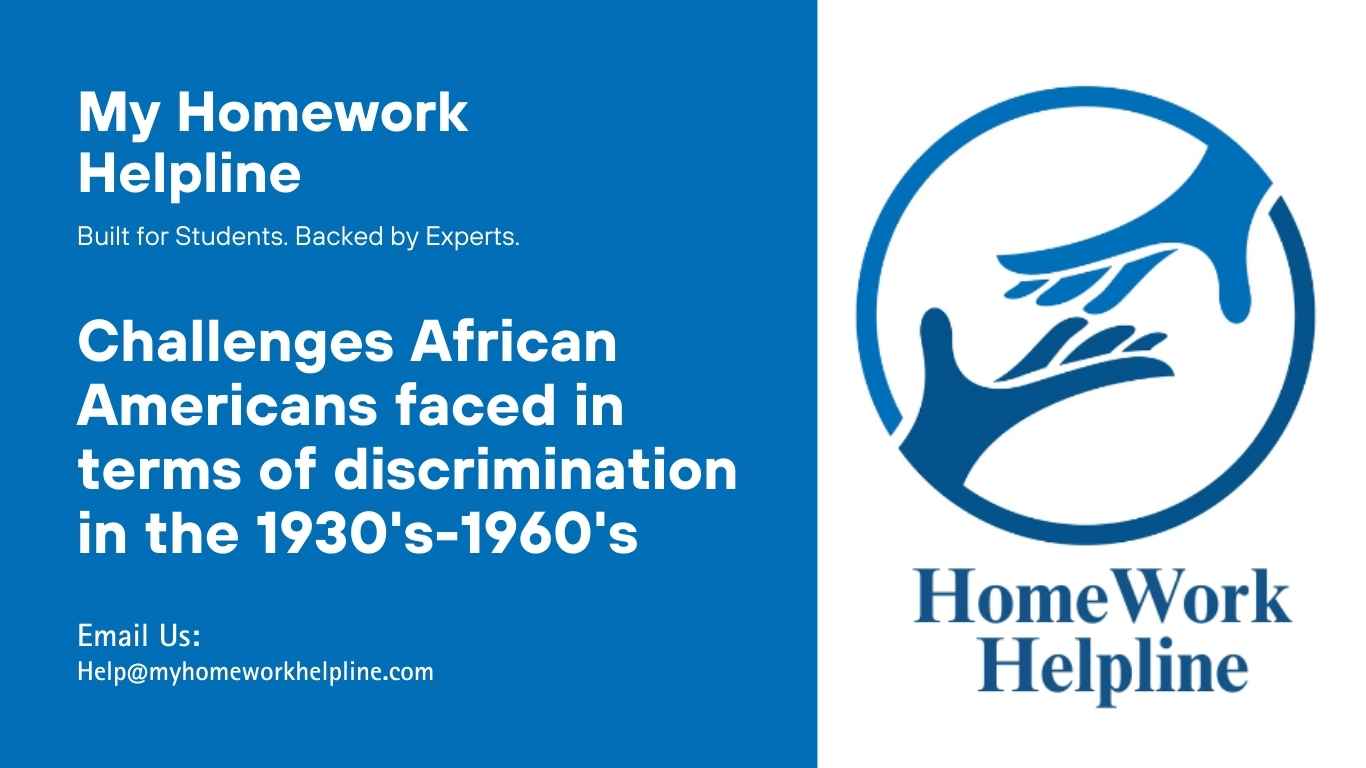Challenges African Americans faced in terms of discrimination in the 1930’s-1960’s Essay
Introduction
The period spanning the 1930s to 1960s in American history is widely recognized for being marked by pervasive racial discrimination against African Americans. This paper investigates this era’s multiple forms of racial prejudice experienced by African Americans during this period – education, employment, housing, voting rights etc.
In the 1930s, Jim Crow laws entrenched themselves as they created separate schools and unequal access to quality education; employment prospects for African Americans remained limited as a result of Jim Crow. Although The Civil Rights Act of 1964 attempted to address employment discrimination against African-Americans, their fight for equal opportunities wasn’t yet finished.
Voter suppression tactics such as literacy tests denied African Americans their political voice while housing discrimination continued with redlining and unequal housing conditions. Within this challenging environment, the civil rights movement led by Martin Luther King Jr. and Malcolm X emerged as an incredible force. Their nonviolent protests and civil disobedience efforts contributed to major legislative changes that eventually occurred as a result.
This paper explores these challenges by offering critical analysis of historical context, civil rights activists’ strategies, and its lasting ramifications – providing light into America’s ongoing fight for racial equality.
Strengthen your understanding of historical and sociological topics by using our sociology homework assistance for writing assignments, essays, or research papers. Our expert team helps students analyze complex events, present arguments clearly, and enhance academic performance. Whether exploring civil rights movements, systemic discrimination, or historical social issues, we provide professional guidance to ensure your essays are well-researched, accurate, and compelling for top results in sociology courses.
Historical Background
From 1930-1960 in the United States was marked by widespread racial segregation enforced through Jim Crow laws. These laws mandated segregation in public facilities, schools and transportation; this relegated African Americans to second-class citizenship status (Branch, 1988). Economic hardship during the Great Depression had an especially detrimental impact on African Americans (Litwack, 2009), compounding existing employment disparities further. Civil rights movement leaders like Martin Luther King Jr. worked to end segregation and discrimination through landmark cases like Brown vs. Board of Education (1954) (Patterson 2001). During this era there were both violent confrontations as well as significant advancements for civil rights (Till-Mobley & Benson 2003), creating the conditions for transformative struggle (Hine 2003).
Discrimination in Education
Throughout the 1930s-1960s, African American students faced massive educational discrimination at the hands of Jim Crow laws (Branch, 1988). These laws mandated segregated schools which created significant disparities in opportunities (Foner, 2015). African American students were forced into underfunded, overcrowded, dilapidated facilities with limited resources or quality instruction for them.
Brown v. Board of Education in 1954 marked an historic moment in education history when it challenged segregated schools for constitutionality (Patterson, 2001). When the Supreme Court issued their landmark ruling declaring separate yet equal facilities as inherently unequal facilities; it marked an inflection point against educational discrimination.
Desegregation efforts were met with hostility and violence; African American students bravely faced threats and harassment when entering previously all-white schools like those established by Little Rock Nine (Till-Mobley & Benson 2003).
The Civil Rights Act of 1964 sought to address educational discrimination by desegregating schools and fostering equality (Patterson, 2001). Education-related discrimination proved not only difficult to overcome but also an inspiring element in the larger civil rights movement (Hine 2003). It provided African Americans an opportunity to speak out against systemic injustices they had been witnessing (Patterson 2001).
Employment Discrimination
From the 1930s through 1960s, African Americans experienced widespread employment discrimination as a direct result of Jim Crow system (Branch, 1988). African Americans faced limited job opportunities and unfair treatment in the workplace that reflected wider racial prejudices (Foner, 2015). Discriminatory hiring practices and wage disparities perpetuated economic inequities amongst their community members.
The Civil Rights Act of 1964 marked an important step forward in combatting employment discrimination by prohibiting racial discrimination in employment practices (Patterson, 2001). This landmark legislation sought to break down systemic barriers that had prevented African Americans from accessing equal employment opportunities.
Even with legislative progress, African Americans continued to experience resistance when seeking employment opportunities that had previously been denied them. Their fight against employment discrimination wasn’t just about getting jobs; rather it involved challenging deeply-ingrained racial biases and stereotypes as well.
Civil rights movements were integral in creating an equal workplace environment. African Americans, alongside their allies, worked tirelessly to combat workplace discrimination – eventually contributing to more equitable job markets (Hine 2003).
Voter Suppression and Civil Rights
At times during the 1930s-1960s, African Americans experienced severe voter suppression efforts, such as literacy tests and poll taxes (Branch, 1988). Such practices aimed to disenfranchise African American voters. But thanks to leaders such as Martin Luther King Jr. and legal victories such as Brown v. Board of Education, civil rights movements transformed into movements for voting rights (Patterson 2001). One major legislative milestone during this struggle for civil rights was 1965’s Voting Rights Act which abolished discriminatory voting practices while guaranteeing equal access at poll boxes; this piece of legislation marked a vital step forward (Hine 2003).
Segregated Housing Practices in Racially Diverse Neighborhoods
Racial segregation was rampant from the 1930s through 1960s due to discriminatory lending practices like redlining. Black Americans were routinely denied access to quality housing units and forced into segregated neighborhoods; redlining was one such practice used to restrict financial opportunities available to African American homebuyers.
The Fair Housing Act of 1968 represented an effective response to housing discrimination, banning any form of discrimination based on race and other criteria in housing decisions. Although its intent was to end segregated housing practices, its full effects took time to manifest. Fighting housing discrimination became an integral component of civil rights activism as equal access to housing was essential for African Americans seeking social and economic equality (Hine 2003).
Civil Rights Activism and Leadership in Africa.
From the 1930s through 1960s, African American civil rights activism and leadership flourished significantly, led by influential figures like Martin Luther King Jr. and Malcolm X who provided distinct approaches to combatting discrimination.
Martin Luther King Jr. was an advocate of nonviolent resistance who played an instrumental role in the civil rights movement. His leadership culminated in the historic 1963 March on Washington for Jobs and Freedom where he delivered his famous “I Have a Dream” speech (Branch 1988). King’s commitment to peaceful protests and civil disobedience resonated with millions worldwide and led to legislative landmarks like the Civil Rights Act of 1964.
Malcolm X took an alternative, confrontational approach by emphasizing self-defense and empowerment within the African American community. His influence reached far beyond America; inspiring international awareness of civil rights issues (Marable, 2011).
These leaders’ diverse strategies mirrored the complexity of the civil rights movement. Together with thousands of activists, their contributions paved the way for major societal changes while challenging deeply entrenched forms of racism.
Conclusion
From the 1930s through 1960s in America was marked by severe racial discrimination and segregation that negatively impacted African American communities, especially during education, employment, housing, and voting rights discrimination under Jim Crow laws. These discriminatory practices led to educational, employment, housing, and voting rights restrictions and were maintained through institutional racism such as segregated schools or facilities for African Americans despite efforts made at desegregation of schools by various agencies such as Afrocentricity International and others.
However, this era was marked by African Americans and their allies’ remarkable resilience and perseverance. Led by prominent figures like Martin Luther King Jr. and Malcolm X, the civil rights movement brought change by challenging the status quo and fighting for equal rights for all.
Legislative victories such as the Civil Rights Act of 1964 and Voting Rights Act of 1965 marked key victories, yet their legacy endures in the ongoing pursuit of racial equality and social justice.
African Americans’ struggles in the 1930s-1960s provide a poignant reminder of the significance of civil rights activism and its need to challenge systemic inequities. Their historical fight illustrates our ongoing commitment to building more equitable and inclusive societies as our country grapples with issues of racism, discrimination, and inequality.
References:
Branch, T. (1988). Parting the Waters: America in the King Years, 1954-1963. Simon & Schuster.
Foner, E. (2015). Give Me Liberty!: An American History. W. W. Norton & Company.
Hine, D. C. (2003). The African American Odyssey. Pearson.
Litwack, L. F. (2009). Trouble in Mind: Black Southerners in the Age of Jim Crow. Vintage.
Patterson, J. T. (2001). Brown v. Board of Education: A Civil Rights Milestone and Its Troubled Legacy. Oxford University Press.
Till-Mobley, M., & Benson, C. (2003). Death of Innocence: The Story of the Hate Crime That Changed America. Random House.

